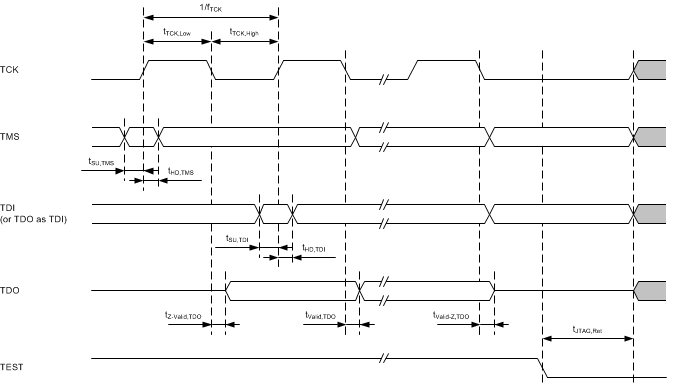ZHCSET6E November 2015 – December 2019 MSP430FR2532 , MSP430FR2533 , MSP430FR2632 , MSP430FR2633
PRODUCTION DATA.
- 1器件概述
- 2修订历史记录
- 3Device Comparison
- 4Terminal Configuration and Functions
-
5Specifications
- 5.1 Absolute Maximum Ratings
- 5.2 ESD Ratings
- 5.3 Recommended Operating Conditions
- 5.4 Active Mode Supply Current Into VCC Excluding External Current
- 5.5 Active Mode Supply Current Per MHz
- 5.6 Low-Power Mode LPM0 Supply Currents Into VCC Excluding External Current
- 5.7 Low-Power Mode (LPM3 and LPM4) Supply Currents (Into VCC) Excluding External Current
- 5.8 Low-Power Mode LPMx.5 Supply Currents (Into VCC) Excluding External Current
- 5.9 Typical Characteristics - Low-Power Mode Supply Currents
- Table 5-1 Typical Characteristics – Current Consumption Per Module
- 5.10 Thermal Resistance Characteristics
- 5.11 Timing and Switching Characteristics
-
6Detailed Description
- 6.1 Overview
- 6.2 CPU
- 6.3 Operating Modes
- 6.4 Interrupt Vector Addresses
- 6.5 Bootloader (BSL)
- 6.6 JTAG Standard Interface
- 6.7 Spy-Bi-Wire Interface (SBW)
- 6.8 FRAM
- 6.9 Memory Protection
- 6.10
Peripherals
- 6.10.1 Power-Management Module (PMM)
- 6.10.2 Clock System (CS) and Clock Distribution
- 6.10.3 General-Purpose Input/Output Port (I/O)
- 6.10.4 Watchdog Timer (WDT)
- 6.10.5 System (SYS) Module
- 6.10.6 Cyclic Redundancy Check (CRC)
- 6.10.7 Enhanced Universal Serial Communication Interface (eUSCI_A0, eUSCI_B0)
- 6.10.8 Timers (Timer0_A3, Timer1_A3, Timer2_A2 and Timer3_A2)
- 6.10.9 Hardware Multiplier (MPY)
- 6.10.10 Backup Memory (BAKMEM)
- 6.10.11 Real-Time Clock (RTC)
- 6.10.12 10-Bit Analog-to-Digital Converter (ADC)
- 6.10.13 CapTIvate Technology
- 6.10.14 Embedded Emulation Module (EEM)
- 6.11 Input/Output Diagrams
- 6.12 Device Descriptors
- 6.13 Memory
- 6.14 Identification
- 7Applications, Implementation, and Layout
- 8器件和文档支持
- 9机械、封装和可订购信息
封装选项
机械数据 (封装 | 引脚)
散热焊盘机械数据 (封装 | 引脚)
- RHB|32
订购信息
Table 5-27 JTAG, 4-Wire Interface
over recommended ranges of supply voltage and operating free-air temperature (unless otherwise noted) (see Figure 5-18)| PARAMETER | VCC | MIN | TYP | MAX | UNIT | |
|---|---|---|---|---|---|---|
| fTCK | TCK input frequency(1) | 2 V, 3 V | 0 | 10 | MHz | |
| tTCK,Low | TCK low clock pulse duration | 2 V, 3 V | 15 | ns | ||
| tTCK,High | TCK high clock pulse duration | 2 V, 3 V | 15 | ns | ||
| tSU,TMS | TMS setup time (before rising edge of TCK) | 2 V, 3 V | 11 | ns | ||
| tHD,TMS | TMS hold time (after rising edge of TCK) | 2 V, 3 V | 3 | ns | ||
| tSU,TDI | TDI setup time (before rising edge of TCK) | 2 V, 3 V | 13 | ns | ||
| tHD,TDI | TDI hold time (after rising edge of TCK) | 2 V, 3 V | 5 | ns | ||
| tZ-Valid,TDO | TDO high impedance to valid output time (after falling edge of TCK) | 2 V, 3 V | 26 | ns | ||
| tValid,TDO | TDO to new valid output time (after falling edge of TCK) | 2 V, 3 V | 26 | ns | ||
| tValid-Z,TDO | TDO valid to high-impedance output time (after falling edge of TCK) | 2 V, 3 V | 26 | ns | ||
| tJTAG,Ret | Spy-Bi-Wire return to normal operation time | 15 | 100 | µs | ||
| Rinternal | Internal pulldown resistance on TEST | 2 V, 3 V | 20 | 35 | 50 | kΩ |
(1) fTCK may be restricted to meet the timing requirements of the module selected.
 Figure 5-18 JTAG 4-Wire Timing
Figure 5-18 JTAG 4-Wire Timing